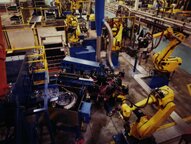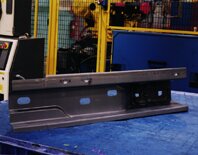|
Robotic welding cell keeps stamping/assembly shop on top
This tier-1 automotive supplier implements flexible technologies that provide continuous improvement of operations and yield value added productivity.
Becoming a leading supplier to the automotive industry takes a lot of hard work. Staying on top can be an even tougher challenge. But it’s been a challenge that the Schaller Corporation of Chesterfield, Mich., has met head on for more than 20 years and won. Historically a stamping supplier of brackets, supports and other structural components to auto and truck makers, the company has a proven track record of not just being a respondent to customers’ demands and supplier guidelines, but more as an anticipator of those needs, being among the first to implement operational enhancements that become standards for others to then follow.
“We’ve always considered ourselves as a value added supplier providing quality, processes and services outside the boundaries of the typical stamping supplier classification,” says Royal Clippert, tooling manager for Schaller Corp. “Early on we began offering assembly processes for many of the components we stamped. Today, in addition to production stampings and assemblies from the Schaller Corporation, the Schaller Group has been formed and has become a single source for a broad range of stamping services, including development of prototype parts plus tool and die building.”

Overall view of one of the two welding cells Custom Machines built for Schaller Corp. |
New robotic welding cells
This value added aspect also extends to the continuous improvements, providing quality, economic and agility advantages, made within the organization. One example of process improvement is the recent acquisition and installation of two robotic welding cells the company has completed at its facility.
The cells were engineered and built by Custom Machines Inc. of Adrian, Mich., specialists in the manufacture and integration of custom assembly machines, cells and complete turnkey systems. The new cells have replaced older, hard-tooled and dedicated systems, which were a combination of automation and manual operations and made virtually obsolete by part changes for the 2002 vehicle model year.
“The new assemblies required a quantum jump in the process with the part size and number of components doubling, and the addition of a secondary forming operation,” said Clippert. “The robotic welding cells have been the bridge we needed to make the jump successfully and achieve the quality, throughput and machine reliability required.”

Close-up of a completed pickup truck cab hold down bracket. |
The parts/assemblies being formed and assembled by the cells are referred to as left and right side cab hold down brackets. Each consists of a rail, a subassembly and three tap plates welded together to form a single unit. The assembled, U-shaped brackets are used in the building of pickup trucks and function as the mounting surface between the cab and the vehicle’s frame. They also provide a secure attachment for seating mechanisms via the tap plates. The brackets weigh approximately 10 pounds, measuring 3 feet long and 8 inches wide.
Prior to the installation of the two new systems, the dedicated units consisted of a four station rotary table, with eight welding guns, in addition to a material handling person. Also, the previous assembly configuration consisted of only three components.
The new cells (one for the left side and one for the right side bracket) include the secondary forming press; an intracell material handling robot; two 7-axis servo robots equipped with resistance welding guns; a six-station, 89.2-inch-diameter indexing table; a fourth robot that unloads and packs the assemblies into their dedicated shipping containers; and a feed and positioning mechanism for the tap plates.
The first robot picks up the rail from the stamping press and loads it at the first position of the indexing table. Then it picks up the sub assembly from its load conveyor and places it in position on the rail. The table rotates to the first welding stations where the robot welds the three tap plates in place and places two welds on the subassembly. The table rotates again to the second station where the welding robot number two completes eight additional welds on the subassembly. A total of 16 welds are performed per bracket.
Incorporated into the cell are sensors that ensure tap plate pickup and placement, and rail and subassembly presence. There is also a station for checking threads on the subassembly. The cycle time to complete one hold down bracket is 23.5 seconds, resulting in approximately 153 pieces per hour.
The final rotation moves the assemblies into position for the fourth robot to unload the assemblies, placing them in the shipping containers that hold up to 102 units. A single cell attendant delivers parts to the cell and removes shipping containers when full directly to the shipping department for delivery to the automaker’s assembly operation.
To develop the system, first Schaller defined and created an overview of the process. This plan was presented to CMI engineers, and working together, the two teamed up to refine and formalize the system’s design. From there, CMI completed the engineering work and building process, including software generations and control integration between the various units. A critical factor in the success of the cells, according to Mr. Clippert, has been the synchronization of the assembly/welding operations with the cycle time and performance of the press purchased by Schaller.
“The man-machine interface is one of the most impressive features of the system,” he said. “The overall control is eloquent in its performance, a powerful voice that speaks to all the other elements and makes them function as one.”
Back to Web Exclusives contents
Back to MRO Today front page
|







